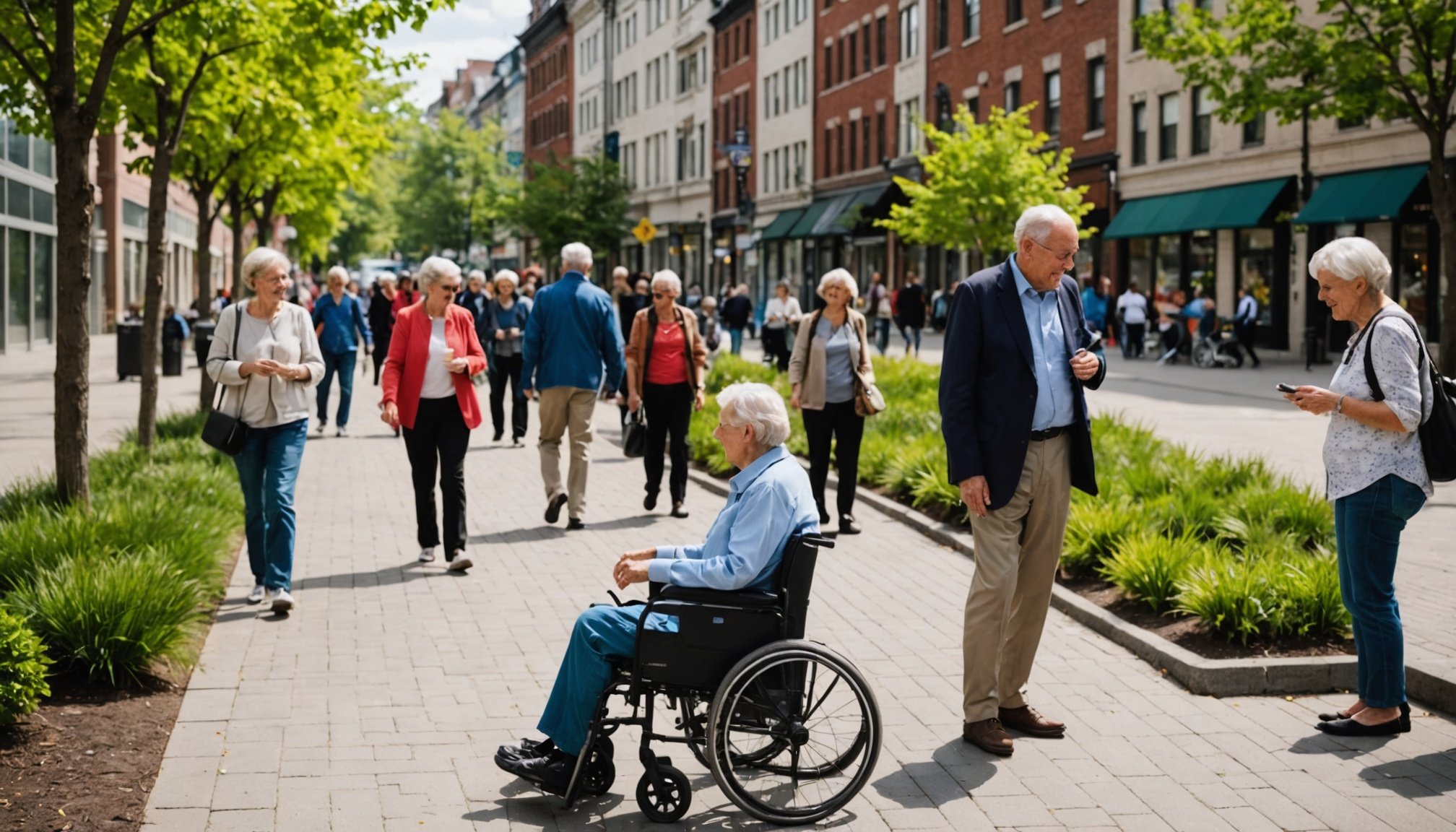Introduction to Urban Public Spaces for Seniors
Seniors face unique challenges in navigating urban spaces, highlighting the necessity of prioritising accessibility in urban design. Current urban environments often neglect the mobility needs of older adults, resulting in significant barriers. These barriers can include uneven pavements, lack of seating, and insufficient signage, making city life challenging for senior citizens.
Incorporating urban design principles to better accommodate seniors improves not only functionality but also safety and independence. Thoughtful design can foster a welcoming atmosphere where seniors feel confident moving about. Properly maintained sidewalks, clear signage, and well-placed benches are fundamental elements contributing to a senior-friendly city. These features help prevent accidents and encourage seniors to engage more in community life.
Topic to read : Discover the enduring benefits of opting for high-quality building materials in your projects
The objectives in designing this type of inclusive environment are not just about meeting regulatory requirements, but enriching the quality of life for seniors. Applying these urban design principles can lead to inclusive spaces where all community members interact effortlessly. This would bridge gaps between generations and reduce social isolation, a prevalent issue among the elderly.
When cities implement actionable measures focused on access for seniors, they not only cater to a specific demographic but ultimately create spaces that benefit everyone.
In parallel : Transforming cityscapes: how innovative landscape design can boost urban biodiversity in new real estate projects
Design Principles for Accessibility
Creating an accessible urban space is crucial for fostering inclusivity and usability for everyone. Accessibility Standards and Design Guidelines play a vital role in achieving this aim.
Key Design Principles
-
Universal Design: This involves designing spaces that are usable by all individuals, regardless of their abilities. No more retrofitting. Instead, integrate accessibility from the ground up.
-
Inclusive Architecture: Buildings and open spaces should be designed to accommodate a varied range of physical and cognitive abilities. This ensures that every person, regardless of their needs, can navigate and utilise the space effectively.
-
Flexibility and Adaptability: It’s essential for spaces to adapt to changes in user needs over time. Incorporating adjustable features or modular elements can allow for a more accommodating environment as technology and societal needs evolve.
The importance of these design principles cannot be overstated, as they contribute to a more equitable society. By following robust design guidelines, planners and architects can create urban environments that are truly accessible, promoting seamless integration and autonomy for all users.
Case Studies of Successful Projects
Exploring successful and innovative designs provides valuable insights into transforming urban spaces for seniors. Each project demonstrates unique solutions, ensuring improved accessibility and community satisfaction.
Project 1: City Park Transformation
The City Park Transformation aimed to breathe new life into public greenery while ensuring it remained senior-friendly. Key features included leveled pathways, ample seating, and clear signage, all enhancing accessibility for seniors. Community feedback highlights the positive impact, noting increased park visits among seniors. Local seniors appreciated the thoughtful design, which encouraged social interaction and outdoor activities.
Project 2: Senior-Centric Urban Plaza
This urban plaza focuses on senior interaction and mobility through strategic design. Elements like smooth walkways, shaded areas, and interactive spaces foster connection and movement. Measuring success through community involvement showed an uptick in senior gatherings and events. The lessons learned emphasize the importance of engaging seniors early in design processes and utilizing their input for project success.
Project 3: Walkable Neighborhoods
Creating pedestrian-friendly environments, this project incorporated wide pavements and non-slip surfaces to enhance safety. Added features such as adequate lighting and benches catered specifically to seniors’ comfort. Long-term benefits include increased foot traffic and community bonds, illustrating that thoughtful neighborhood planning improves quality of life for all residents, especially seniors.
Accessibility Features Checklist
Creating public spaces that are accessible to everyone involves a comprehensive approach, paying keen attention to various elements. This Urban Space Checklist ensures inclusivity, allowing ease of movement and enjoyable experiences for individuals with diverse needs.
When planning public areas, some essential features should be prioritized:
-
Ramps and Elevators: These facilitate mobility for those using wheelchairs or strollers, ensuring that everyone can navigate spaces efficiently.
-
Public Restrooms: Equipped with grab bars and ample space, these amenities should cater to users with mobility impairments.
Mobility aids and assistive technologies also play a crucial role in enhancing accessibility. These tools include signage in braille and hearing loops in public venues. Such features offer assistance to those with visual or auditory impairments, respectively.
Additionally, considerations for safe navigation involve making pathways free of obstructions and ensuring they are well-lit. It’s imperative to maintain tranquility by managing noise levels where possible, thereby providing a comfortable environment for people sensitive to sound.
By integrating these elements, public spaces can be transformed into inclusive environments, encouraging participation and engagement from all community members.
Community Engagement Strategies
Incorporating community involvement is essential, especially when developing initiatives that directly impact seniors. Engaging the elderly in the design process ensures that their needs and preferences are adequately addressed. This can be achieved through stakeholder engagement strategies that include focus groups and in-depth interviews. By gathering insights from the elderly, projects can align more closely with their expectations and foster a sense of ownership.
To gain valuable feedback, organizing workshops and participatory design sessions is highly effective. These methods allow seniors to express their perspectives while enabling planners to tailor programs that are both effective and inclusive. Keeping communication channels open with this demographic enriches the overall design process.
Moreover, building strong partnerships with local organizations is vital. Collaborations with senior centers, health care facilities, and community groups can offer unparalleled support, leveraging their expertise to enhance outreach. These partnerships not only bolster resources but also create a network of committed stakeholders invested in the project’s success.
Successful community engagement ensures that both seniors and partners feel valued and heard. By prioritizing community involvement and engaging key stakeholders, projects can elicit more comprehensive, sustainable, and well-received outcomes.
Conclusion: Enhancing Quality of Life for Seniors
Improving the quality of life for seniors hinges on thoughtful urban planning and senior inclusion. At the heart of this endeavour are design elements that prioritise accessibility and community integration. Ensuring easy access to public spaces, transportation, and healthcare services are fundamental. The integration of ramps, clear signage, and tactile paths in urban spaces promotes mobility and independence.
Looking to the future, urban planning must continue to evolve with seniors’ needs in mind. Embracing technology, for instance, with smart street lighting and real-time transportation updates, can offer both safety and convenience. Inclusion extends beyond physical spaces, urging the incorporation of community programs that encourage social interaction and lifelong learning for seniors.
The long-term impacts of designing accessible public spaces encompass entire communities. Such environments encourage intergenerational interaction, dispelling stereotypes about aging and fostering respect and inclusion among all age groups. Moreover, creating senior-friendly spaces today addresses the needs of a rapidly aging population, preparing societies for demographic shifts. As these initiatives become standard, communities will witness improved quality of life for both current and future senior residents. This commitment to inclusivity ultimately benefits society as a whole, bringing dynamics of senior inclusion into the spotlight.











